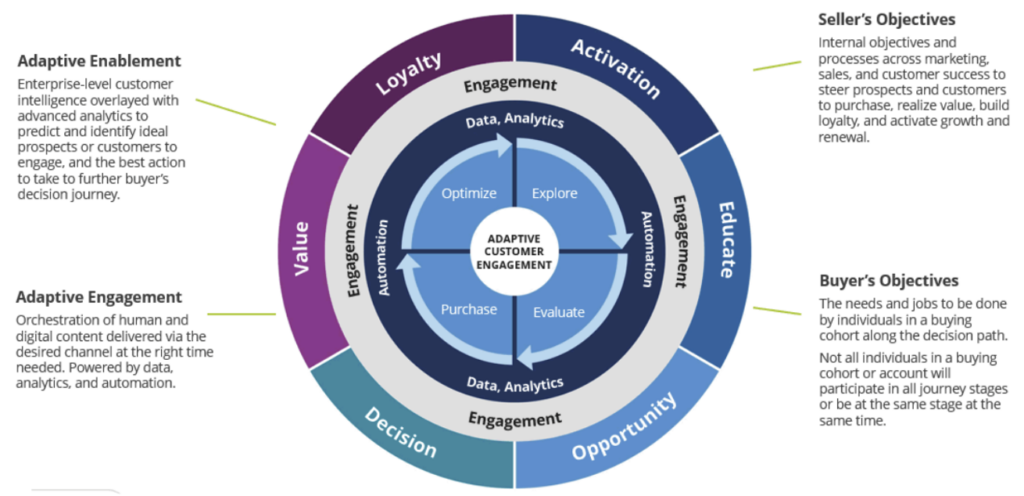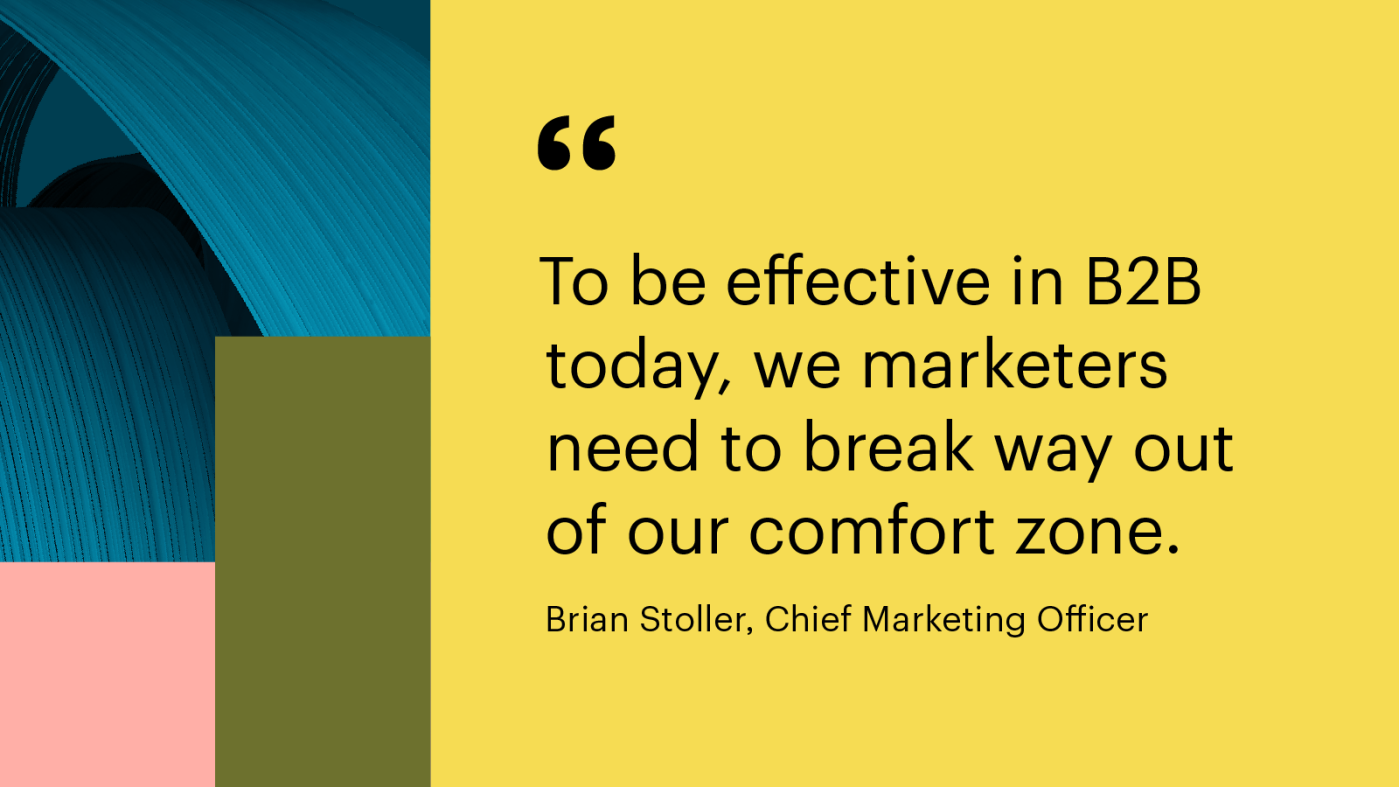“Digital-first, digital-first, digital-first” – the (not so) new mantra of B2B marketing and sales representing the inevitable crossing of the Rubicon into an era of marketing-led buying. According to IDC’s Tech Buyer Survey, 74% of B2B buyers will work less with traditional in-person salespeople and lean deeper into ecommerce and self-service. And this inevitability has B2B marketers and sellers worried.
As B2B sellers, we have taken a long time to get here. And many continue to fight the change and struggle to create a workable and positive relationship between Sales and Marketing that can feed the bottom line by adapting to what today’s buyers want.
Marketing and Sales teams face the persistent challenge of reaching and influencing buyers who are well and truly rooted in the digital ecosystem. And as this new B2B landscape continues to evolve (which it will), it’s crucial to adopt a new approach that enables organizations to create a more personal and, more importantly, useful and educational path to nurture a new cohort of very diverse buying committee members.
Taking the leap with a new approach can be daunting, but it doesn’t have to be. New research from IDC provides B2B vendors with critical data and insights into this evolving landscape. Let’s start with what we know about these new buyers.
B2B buyers aren’t any different from B2C or DTC buyers
Four key points surfaced in our sister company IDC’s research:
- Digital first, always: Today’s buyers are fully plugged into the digital world. They browse, chat, research, and shop across multiple online channels, making eCommerce their preferred style for all purchases – now including B2B. To win over these buyers, we have to embrace the digital realm and speak their language, not ours.
- Customer experience rules: Consumers now call the shots. Leave downloadable PDF white papers behind and focus more on interactive and immersive content like videos, webinars, and infographics that will differentiate you from your competition. It doesn’t matter if the customers are GenZ or Boomers, win them over with what they all crave – memorable interactions.
- Personalization is table stakes: One size does not fit all and never did. B2B buyers expect content tailored to their needs in real time. Whether digital natives or digital immigrants, personalized engagement matters – a lot.
- The current funnel model falls short: In today’s B2B buying age, a diverse committee calls the shots, not just the executive responsible for cutting the check. To succeed, marketing and sales must be agile, adaptable, and utterly customer centric. It’s their journey, their way – with vital information delivered with a human, personal touch.
For B2B marketing and selling teams, this all adds up to a new way of approaching and engaging the buyer – one that abandons the generic messaging and linear nurture track that we’ve perfected and instead puts the buyer in control. It also means that, to truly be effective in the B2B marketing space, we need to break way out of our comfort zone.
Enter ACE: a new model for a new kind of B2B buyer
IDC knew a change in B2B sales approach was needed and undertook a research effort that has resulted in what they have coined: the ACE model.
Adaptive Customer Engagement, or ACE, was designed to meet the needs of modern B2B buyers and, if done with consideration, will make the buying experience across all aspects of the consumer journey more personal and definitely more in tune with what B2B buyers need – not just what we, as sellers, think they need. ACE is a framework that helps brands identify and accelerate growth opportunities in a continual fashion and aligned to how today’s B2B buying committees actually buy.

ACE is a continuous B2B marketing and customer outreach model, forgoing the classic funnel schema – a virtuous cycle of engagement no matter what stage of the buying journey is active. Data points and insights feed content choices and marketing automations that help marketing drive more personal, one-to-one experiences in the digital realm. And it doesn’t stop with a purchase, nor should it. The relationships built are just as important post-sale as they are prior.
B2B buyers expect B2C experiences and desire true interactions with your brand, interactions that have a direct connection to their unique business challenges. It can’t just be about your product offerings in a vacuum.
If you are looking for a checklist or definitive process, the ACE model is not that. It is a process that’s agile at its core and is unique to each brand and product. Adaptability is paramount because B2B buyers move in many directions at once, all on their own terms. It is the job of B2B Marketing and Sales to think strategically together to identify individual buyer needs to deliver the best resources (digital, traditional, human-to-human) at each need state, which creates a more educational, informative, and effortless experience.
Making it actionable
Obviously, there is no magic bullet to move you forward, but here are some things to ponder and some actions that you can take now to start preparing for and making a change.
- Build customer intelligence, not data lakes: Map the data, understand the gaps, and create a layer of consumer insights. It can’t only be about the numbers. It’s necessary to infuse those stats with human, behavioral queues and triggers.
- Revive the CMO-CIO partnership: ACE requires a tech-enabled marketing team, meaning CMOs and CIOs need to bridge the gap between them in the interest of the business. Consider investing in automation and enterprise level capabilities, all tracking toward a more omnichannel experience that is underpinned by strong governance and digital security.
- Form a team-of-teams partnership with Sales: To put the customer at the heart of all you do, forget the funnel model. Embrace collaboration with teams working together, with common goals, tactics, and KPIs as your framework.
- Modernize your content playbook: Digital-first buyers thirst for immersive content. Stop leaning on PDF case studies and download CTA forms, and instead revise your content marketing approach. Tell stories that weave through the many buyer journeys that happen simultaneously and create narratives that engage each stakeholder on the buying committee personally.
- Bring the right people on board: Hire talent and close skills gaps to be more in tune with the modern marketing/sales landscape. You need digital experience producers, content strategists, data scientists, and tech-savvy minds all working in concert while embracing emerging technologies like AI and augmented reality.
- A sale isn’t the end of marketing: The circular nature of ACE removes the finality that currently exists in the sales cycle by redepositing the sale’s success back into the process. Your customers are an extension of your marketing plan, and who better than the current customer base to help educate and enlighten those embarking on a similar buyer journey? Remember, marketing never sleeps.
- Focus on outcomes, not outputs: Shift your focus from counting leads to tracking real outcomes and revenue growth. Use connected data and analytics to uncover insights, giving you the knowledge to engage your buyers throughout their journey and decision-making process.
I didn’t say this would be easy, but the need is real. Make no mistake, this change in tack will require executive management buy-in to drive the effort and willing sales and marketing teams to play nice in the race-to-revenue sandbox. Remember, this is not an individual competition between organizational departments, it has to be a team sport. That’s a lot of coordination, but the upshot could be massive, for consumers as well as brands.
I would love to hear your thoughts.







